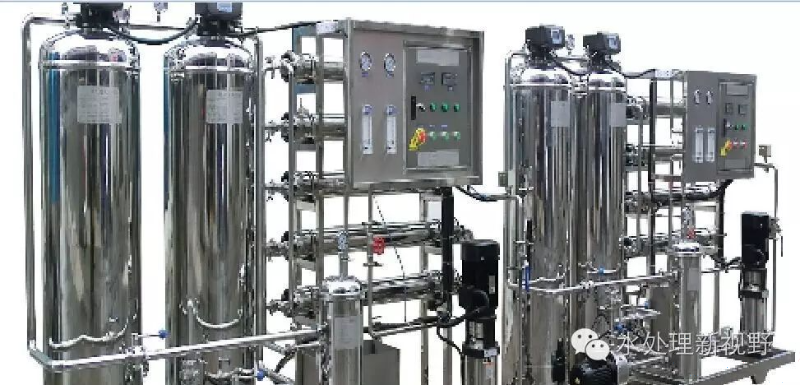Consultation hotline:
(+86)0532-88988868
(+86)0532-88988868
Methods to extend the service life of reverse osmosis membraneAfter the trial of reverse osmosis equipment, we have used two methods to protect the membrane. The equipment was put into trial operation for two days (15~24h), and then maintained with 2% formaldehyde solution; Or after running for 2~6h, use 1% NaHSO3 aqueous solution for maintenance (the air in the equipment pipeline should be drained to ensure that the equipment does not leak, and all inlet and outlet valves should be closed.
1. Prevent damage to membrane properties
New reverse osmosis membrane elements are typically soaked with 1% NaHSO3 and 18% glycerol in aqueous solution and stored in a sealed plastic bag. In the case that the plastic bag is not broken, it will be stored for about 1 year, and its life and performance will not be affected. When the plastic bag is opened, it should be used as soon as possible to avoid the adverse effects on the components due to the oxidation of NaHSO3 in the air. Therefore, the film should be opened as much as possible before use.
After the trial operation of the reverse osmosis equipment, we have used two methods to protect the membrane. The equipment was put into trial operation for two days (15~24h), and then maintained with 2% formaldehyde solution; Or after running for 2~6h, use 1% NaHSO3 aqueous solution for maintenance (the air in the equipment pipeline should be drained to ensure that the equipment does not leak, and all inlet and outlet valves should be closed). Both methods can achieve satisfactory results. The first method is more expensive and is used when there is a long idle time, and the second method is used when the idle time is shorter.

2. Improper operation of reverse osmosis equipment causes damage to membrane performance
2.1 There is residual gas in the reverse osmosis equipment that operates at high pressure, and the formation of air hammer will damage the membrane
There are often two situations: A. After the equipment is emptied, when it is re-run, the gas is quickly boosted and operated without exhaustion. The remaining air should be exhausted under the pressure of 2~4bar, and then gradually increase the pressure. B. When the joint between the pretreatment equipment and the high-pressure pump is not well sealed or leaks (especially the leakage of the microfilter and the pipeline behind it), when the pretreatment water supply is not sufficient, if the microfiltration is blocked, part of the air will be sucked in due to the vacuum in the place where the sealing is not good. The microfilter should be cleaned or replaced to ensure that the pipeline does not leak. In short, the pressure should be gradually increased when there are no bubbles in the flowmeter, and the bubbles found in the operation should be gradually depressurized to check the cause.
2.2 The method of shutting down the reverse osmosis equipment is incorrect
A. When the machine is shut down, the pressure is quickly lowered and not thoroughly flushed. Because the concentration of inorganic salts on the concentrated side of the membrane is higher than that of the raw water, it is easy to scale and pollute the membrane.
B. Rinse with pretreated water with chemical reagents. Membrane contamination can occur during equipment outages due to chemically laden water.
When the reverse osmosis equipment is ready to shut down, the chemical reagent should be stopped, and the pressure should be gradually reduced to about 3bar and rinsed with pretreated water for 10min until the TDS of the concentrated water is very close to the TDS of the raw water.
2.3 Poor disinfection and maintenance of reverse osmosis equipment leads to microbial contamination
This is a common problem in the use of composite polyamide membranes, because the polyamide membrane has poor residual chlorine resistance, chlorine and other disinfectants are not correctly added in use, and users do not pay enough attention to the prevention of microorganisms, which can easily lead to microbial pollution. At present, the pure water microorganisms produced by many manufacturers exceed the standard, which is caused by poor disinfection and maintenance.
The main manifestations are: when leaving the factory, the RO equipment is not maintained with disinfectant; The entire pipeline and pretreatment equipment were not disinfected after the equipment was installed; Intermittent operation without disinfection and maintenance measures; Failure to regularly disinfect pretreatment equipment and reverse osmosis equipment; The maintenance fluid is not effective or the concentration is insufficient.
2.4 Poor monitoring of residual chlorine in reverse osmosis equipment
If the pump with NaHSO3 fails or the chemical solution fails, or the membrane is damaged due to residual chlorine when the activated carbon is saturated.
3. Damage to the membrane performance caused by untimely cleaning and incorrect cleaning methods
In the process of using the equipment, in addition to the normal attenuation of performance, the attenuation of equipment performance caused by pollution is more serious. The usual pollution mainly includes chemical scale, organic matter and colloidal pollution, microbial pollution, etc. Different pollution exhibits different symptoms. The symptoms of membrane fouling proposed by different membrane companies are also different.
In the project, we found that the length of the pollution time is different, and the symptoms are also different. For example, when the membrane is polluted with calcium carbonate scale, and the pollution time is one week, it is mainly manifested as a rapid decrease in the desalination rate, a slow increase in the pressure difference, and no obvious change in water production, and the performance can be fully restored by cleaning with citric acid. The pollution time is one year (a water purifier), the salt flux increases from the initial 2mg/L to 37mg/L (raw water is 140mg/L~160mg/L), the water yield decreases from 230L/h to 50L/h, and after cleaning with citric acid, the salt flux decreases to 7mg/L, and the water yield rises to 210L/h.
In addition, pollution is often not singular, and its symptoms are also different, making it more difficult to identify pollution.
To identify the type of pollution, it is necessary to judge the raw water quality, design parameters, pollution index, operation records, equipment performance changes and microbial indicators:
(1) Colloidal pollution: When colloidal pollution occurs, it is usually accompanied by the following two characteristics: A. The microfilter is blocked quickly in the pretreatment, especially the pressure difference increases quickly, and B. The SDI value is usually above 2.5.
(2) Microbial contamination: When microbial contamination occurs, the total number of bacteria in the permeable water and concentrated water of the RO equipment is relatively high, and the maintenance and disinfection must not be carried out as required.
(3) Calcium scale: It can be judged according to the quality of raw water and design parameters. For carbonate water, if the recovery rate is 75%, the LSI of the concentrate should be less than 1 if the antiscalant is added to the design; The LSI of the concentrate should be less than zero when the antiscalant is not added, and calcium scale will generally not be generated.
(4) 1/4 inch PVC plastic pipe can be inserted into the module to test the performance changes of different parts of the module to judge.
(5) Judge the type of pollution according to the change of equipment performance.
(6) Pickling (such as citric acid, dilute HNO3) can be used to judge the calcium scale according to the cleaning effect and cleaning solution, and further confirmed by the composition analysis of the cleaning solution.
(7) Chemical analysis of the cleaning solution: take the raw water, the cleaning stock solution, and the cleaning solution, and analyze three samples.
Once the type of contamination has been determined, it can be cleaned as described in Table 1 and then disinfected. When the type of contamination cannot be determined, cleaning is usually done in the steps of cleaning (3) + disinfection + 0.1% HCl (pH 3). The author's use of cleaning solution (1) + cleaning solution (3) + disinfection steps is also very effective.


